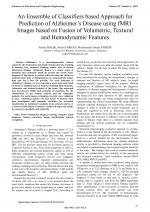| 1/2018 - 8 |
| View the paper record and citations in |
| Click to see author's profile in |
| Download PDF |
Author keywords
biomedical image processing, computer aided diagnosis, feature extraction, image classification, pattern recognition
References keywords
alzheimer(51), disease(38), imaging(12), functional(12), fmri(12), brain(11), diagnosis(10), dementia(8), classification(8), neuroimage(7)
Blue keywords are present in both the references section and the paper title.
About this article
Date of Publication: 2018-02-28
Volume 18, Issue 1, Year 2018, On page(s): 61 - 70
ISSN: 1582-7445, e-ISSN: 1844-7600
Digital Object Identifier: 10.4316/AECE.2018.01008
Web of Science Accession Number: 000426449500008
SCOPUS ID: 85043280771
Abstract
Alzheimer's is a neurodegenerative disease caused by the destruction and death of brain neurons resulting in memory loss, impaired thinking ability, and in certain behavioral changes. Alzheimer disease is a major cause of dementia and eventually death all around the world. Early diagnosis of the disease is crucial which can help the victims to maintain their level of independence for comparatively longer time and live a best life possible. For early detection of Alzheimer's disease, we are proposing a novel approach based on fusion of multiple types of features including hemodynamic, volumetric and textural features of the brain. Our approach uses non-invasive fMRI with ensemble of classifiers, for the classification of the normal controls and the Alzheimer patients. For performance evaluation, ten-fold cross validation is used. Individual feature sets and fusion of features have been investigated with ensemble classifiers for successful classification of Alzheimer's patients from normal controls. It is observed that fusion of features resulted in improved results for accuracy, specificity and sensitivity. |
| References | | | Cited By |
Web of Science® Times Cited: 6 [View]
View record in Web of Science® [View]
View Related Records® [View]
Updated 2 days ago
SCOPUS® Times Cited: 8
View record in SCOPUS® [Free preview]
View citations in SCOPUS® [Free preview]
[1] Convolutional Neural Network Based Prediction of Conversion from Mild Cognitive Impairment to Alzheimer's Disease: A Technique using Hippocampus Extracted from MRI, MUKHTAR, G., FARHAN, S., Advances in Electrical and Computer Engineering, ISSN 1582-7445, Issue 2, Volume 20, 2020.
Digital Object Identifier: 10.4316/AECE.2020.02013 [CrossRef] [Full text]
[2] Deep learning for Alzheimer's disease diagnosis: A survey, Khojaste-Sarakhsi, M., Haghighi, Seyedhamidreza Shahabi, Ghomi, S.M.T. Fatemi, Marchiori, Elena, Artificial Intelligence in Medicine, ISSN 0933-3657, Issue , 2022.
Digital Object Identifier: 10.1016/j.artmed.2022.102332 [CrossRef]
[3] Study of Alzheimer’s disease brain impairment and methods for its early diagnosis: a comprehensive survey, Pallawi, Shruti, Singh, Dushyant Kumar, International Journal of Multimedia Information Retrieval, ISSN 2192-6611, Issue 1, Volume 12, 2023.
Digital Object Identifier: 10.1007/s13735-023-00271-y [CrossRef]
[4] Early Detection of Change by Applying Scale-Space Methodology to Hyperspectral Images, Uteng, Stig, Johansen, Thomas Haugland, Zaballos, Jose Ignacio, Ortega, Samuel, Holmström, Lasse, Callico, Gustavo M., Fabelo, Himar, Godtliebsen, Fred, Applied Sciences, ISSN 2076-3417, Issue 7, Volume 10, 2020.
Digital Object Identifier: 10.3390/app10072298 [CrossRef]
[5] Diagnosis of Alzheimer's Disease from Brain Magnetic Resonance Imaging Images using Deep Learning Algorithms, SUGANTHE, R. C., LATHA, R. S., GEETHA, M., SREEKANTH, G. R., Advances in Electrical and Computer Engineering, ISSN 1582-7445, Issue 3, Volume 20, 2020.
Digital Object Identifier: 10.4316/AECE.2020.03007 [CrossRef] [Full text]
Disclaimer: All information displayed above was retrieved by using remote connections to respective databases. For the best user experience, we update all data by using background processes, and use caches in order to reduce the load on the servers we retrieve the information from. As we have no control on the availability of the database servers and sometimes the Internet connectivity may be affected, we do not guarantee the information is correct or complete. For the most accurate data, please always consult the database sites directly. Some external links require authentication or an institutional subscription.
Web of Science® is a registered trademark of Clarivate Analytics, Scopus® is a registered trademark of Elsevier B.V., other product names, company names, brand names, trademarks and logos are the property of their respective owners.
Faculty of Electrical Engineering and Computer Science
Stefan cel Mare University of Suceava, Romania
All rights reserved: Advances in Electrical and Computer Engineering is a registered trademark of the Stefan cel Mare University of Suceava. No part of this publication may be reproduced, stored in a retrieval system, photocopied, recorded or archived, without the written permission from the Editor. When authors submit their papers for publication, they agree that the copyright for their article be transferred to the Faculty of Electrical Engineering and Computer Science, Stefan cel Mare University of Suceava, Romania, if and only if the articles are accepted for publication. The copyright covers the exclusive rights to reproduce and distribute the article, including reprints and translations.
Permission for other use: The copyright owner's consent does not extend to copying for general distribution, for promotion, for creating new works, or for resale. Specific written permission must be obtained from the Editor for such copying. Direct linking to files hosted on this website is strictly prohibited.
Disclaimer: Whilst every effort is made by the publishers and editorial board to see that no inaccurate or misleading data, opinions or statements appear in this journal, they wish to make it clear that all information and opinions formulated in the articles, as well as linguistic accuracy, are the sole responsibility of the author.





